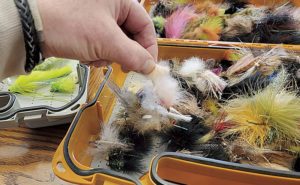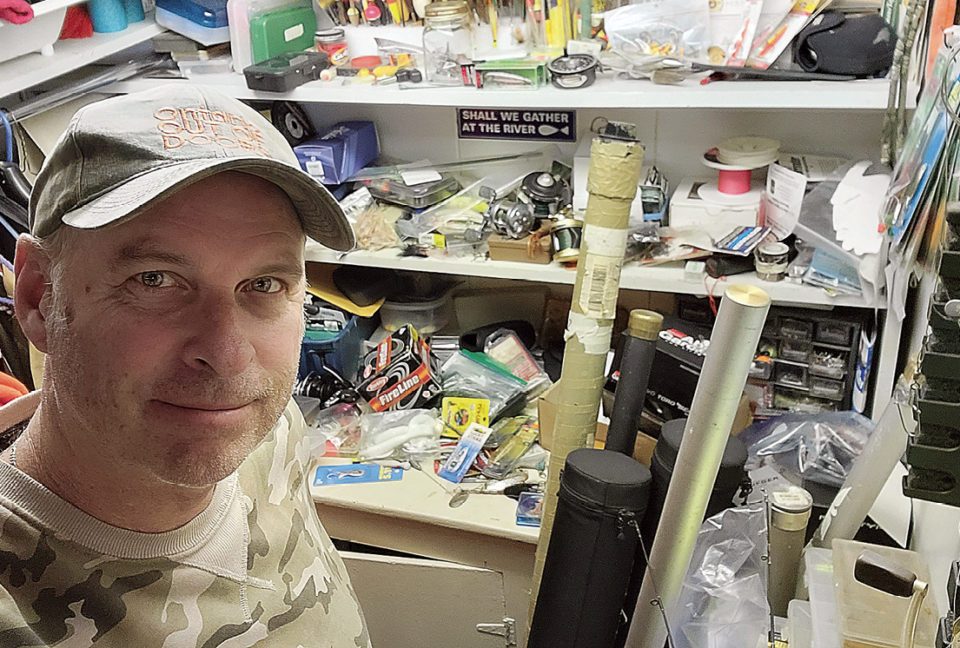I’m not sure why it happens, but every fall I do the same thing: when the hunting bug strikes, the fishing gear is quickly abandoned, usually in a terrible state of disarray. Every year I promise myself the tackle cyclone won’t happen; every year it does.
It’s hard to know where to start when it comes time to face the music and get the fishing gear organized. The “spinner-rig tumble weed” is usually my first stop. Despite the time spent trying to keep the things organized in my boat, most of my spinner-rigs end up in a ball. It should be easy to unravel these clusters of hooks, spinners and lines, but that’s rarely the case. I spend hours trying to pull them apart. As often as not, frustration wins and the scissors come out. A few well-placed snips and you have the makings of several new spinner rigs. The new spinner rigs are all carefully rolled onto tackle tamers as they should have been when I was done with them. Frustration is replaced by relief. At least until next winter.
One job I enjoy, but is no less frustrating, is the fly vest/fly box sort. It is shocking what a mess my fly boxes can turn into by the end of the open water season. Sorting through fly boxes is often full of weird surprises. The bass popper you had been madly searching for somehow made its way into the boat box with trout streamers. That box of dry flies you couldn’t find had been carefully hidden in a vest side pocket. Plus, how does every single fly in a box come detached from the foam hook holder? As a fly guide, I’m endlessly amazed when an angler cracks a fly box open and it looks like it just came out of a catalogue. My fly boxes rarely look like that even after I’ve sorted through them, never mind during the season. Winter is a good time to look old flies over and check for rusted hooks. Don’t be afraid to throw out a fly that looks compromised. Losing a fish due to a rusty hook is the worst. Masking tape and a sharpie help me remember what box has what flies in it as well. A little TLC will go a long way when it comes to your flies.

In the same way, going through your tackle boxes or storage trays is an exercise that can be illuminating. Whenever I really start digging into various lure boxes and seeing what is there, treasures appear. Lures that I forgot about will surface. Sometimes these lures are ones I would normally use but they ended up being tossed into another drawer or box. Taking all the lures out of a box and putting them on a table will also reveal things like rusty hooks or tarnished spinner blades. Winter is a good time to replace old or damaged hooks and buff up spoons and spinner blades that are dingy. Sometimes lures you never use need to be retired to make room. Create a yard sale box and put those “forever on deck” lures there. You will be amazed at how much room you can create.
Another pre-season fishing task is to check every rod and reel that will be put in service. If I was on the ball the previous year, all the drags will have been loosened before the rod and reels were put into the rafters. It always pays to check both the drag and the line on every reel. Not every fishing reel will need new line each season, especially if you use braid. However, the reels that get the most use almost always get re-spooled. At minimum, I take several feet of old line off every reel, just to be on the safe side. On spinning reels, remove the spools and check for gunk and sand. A soft cloth or even a Q-tip can do wonders on a dirty reel. In some cases, adding a little reel oil to the spindle may be of help—a little will go a long way. Check rods for cracks or guides that are broken off or missing the ceramic centre. A rough-edged line guide is just a busted-off fish waiting to happen.
Finally, if you are a spring steelhead angler, do yourself a favour and check over your waders. There is no experience more miserable than slipping into your favourite creek or river and feeling cold water leaking into your boots. A thorough examination for rips or tears on waders is always a good idea. If you find a tear, a patching kit or some aqua seal will make your spring fishing more comfortable.
Being ready and organized before the open water fishing season arrives is a satisfying feeling. It’s worth the time and will help kill off the last of those late winter days.




